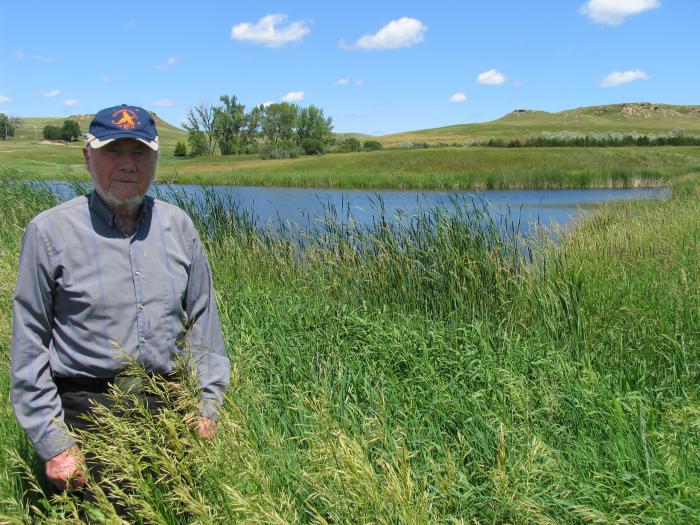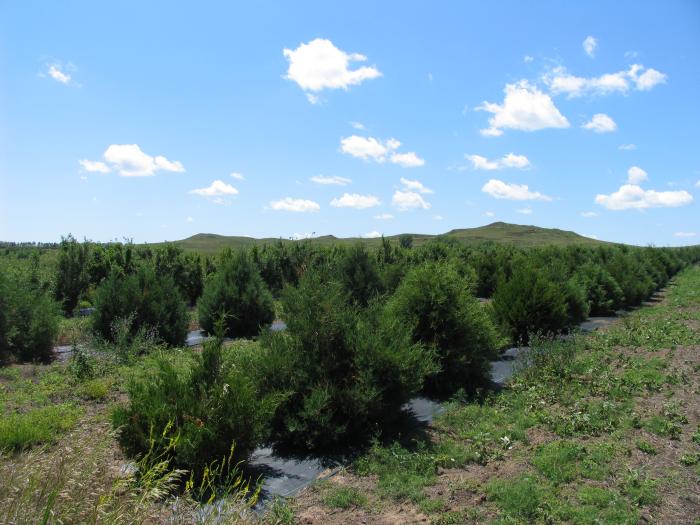NRCS Helps Rancher Turn Conservation Ideas into Reality in Adams County
As Stan Murphy drives along a trail through the lush native grass, a deer and her fawn rush from a tree row.
Luann Dart is a writer from Elgin, N.D.
Murphy’s 839-acre ranch has been turned into a wildlife utopia, with support from the Natural Resources Conservation Service (NRCS). Murphy purchased the Adams County, N.D., ranch near Lemmon, S.D., in 1995, while still living in Fargo with his late wife, who worked at North Dakota State University (NDSU) at the time.

Murphy had worked as a commodity merchant for Cargill then in the grain handling equipment business before retiring in 1993. He had been hunting in western North Dakota since 1972, after moving to Fargo in 1969. “I liked the area and it was great hunting country,” he said. “I had hunted on it and I had recognized it as having wildlife potential, which I was interested in.” The ranch had not been occupied for years, and Murphy spent four years cleaning the property, removing the abandoned buildings, building new structures and then starting to establish grasslands, shelterbelts, wildlife thickets, ponds and food plots on the property. “Stan is always looking to improve his land, and when he has an idea, he'll stop in or call to see what NRCS knows about it,” said Amanda Berg, NRCS district conservationist in Hettinger. “Stan is one of the first landowners I met when I started working in Adams County, and there has been a constant flow of information since. Conservation planning is more effective when there is a conversation and information is being shared. So, while NRCS has provided technical assistance to Stan, there is also a lot that I've learned from his operation. We have talked about wildlife, trees, grazing systems, native plants, food plots, CRP, livestock water systems, weeds and gardens. And now, when I visit his place, I see how conservation has worked for him. He has the wildlife habitat that he wanted, and also has the agriculture component with the grazing system.”

Stan’s first project through NRCS was establishing two large shelterbelts in 1996, including a 25-row, 700-foot long tree row and a 15-row tree row. He’s established several shelterbelts since, including a living snow fence along the north side of a township road leading to his property which was his most recent project four years ago. The living snow fence is comprised of rows of Russian almond and Rocky Mountain juniper trees. The Russian almond, planted on the windward side, is a low, suckering shrub which creates dense thickets for wildlife food and cover, according to NDSU Extension. Between all the tree rows, Murphy fallows the land then plants hard fescue, which is persistent and competitive with other grasses and weeds, according to NRCS. Hard fescue is the “toughest” of all the fescues in that it is the most drought resistant, shade tolerant and disease resistant than the other species. It is a clump type grass that can be grown in very adverse conditions as well as extremely shady areas, NDSU describes. Murphy also keeps weeds controlled on the land adjacent to the tree rows by spraying. As Murphy drives through the hilly property punctuated by woody draws and rocky hilltops, improvements are located around each corner.

Tucked away on flatlands are four different wildlife food plots, planted with wheat, spring wheat, soybeans, millet and sunflowers. Four groups of thickets are planted near the farmstead, comprised of buffalo berry, maple, dogwood and Russian almond. Murphy has also established two ponds on the property, with Plum Creek winding through. “One of the most important projects was the pasture,” Murphy said. A draw which he points to from the window of a cabin on the property, is spring-fed, but was the only water source for cattle in the pasture. The loamy, fine sand under the cattle trails had turned into gullies and erosion was rampant. With NRCS, Murphy added a pipeline and another water tank to the pasture. “That was probably the most major and most important thing, because it greatly improved the pasture and the erosion out there,” he said. The pasture was also divided into three sections of about 160 acres each for rotational grazing, which also required the expertise of NRCS. “The question was how do we divide that pasture because of all the buttes,” Murphy said. Murphy also added a fourth pasture to the rotation by converting an “over-the-hill” piece of alfalfa into grassland. He burned off the alfalfa, then replanted it into a mixture of intermediate wheatgrass, sand bluestem, western wheatgrass and grama grass. A permanent electric fence was placed around the fourth pasture, which is being grazed for the second time this year. With four pastures now in the rotational grazing system, Murphy rents the pastureland to a neighbor, with 140 pairs of cattle grazing this year. Another grasslands project included improving an isolated piece of grassland which had been infested with Kentucky bluegrass. Murphy fallowed it for three years, then planted big bluestem, western wheatgrass and intermediate wheatgrass. Murphy also converted about 100 acres of farmland on the property into grassland by entering it into the CRP program. He’s accomplished these projects using expertise from NRCS. “I had the expertise, which was the main thing, from NRCS,” he said. Today, the 89-year-old Murphy enjoys the property he’s developed, by watching and hunting wildlife. “I could see the handwriting on the wall starting years ago that hunting on private land was going to be more of a problem,” he said, also pointing out he needed a retirement project. “I can’t imagine being retired and not have anything to do,” he said with a laugh. But most of all, he’s proud that he’s developed a conservation habitat at the ranch. “Conservation is important,” he said.

